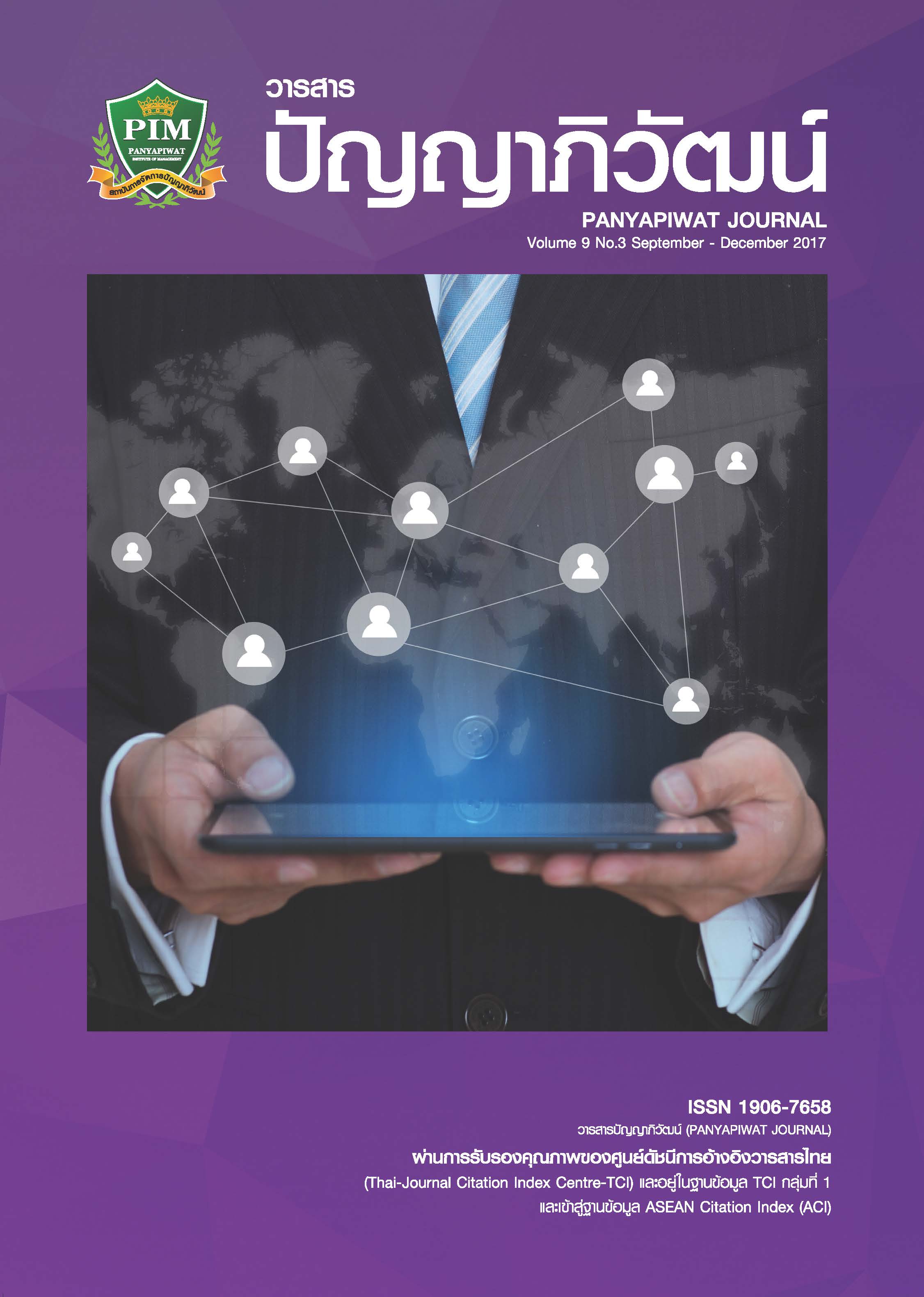การศึกษารูปแบบการตลาดบริการของร้านกาแฟสไตล์บูทีค: กรณีศึกษาเขตอำเภอเมืองจังหวัดเชียงใหม่
Main Article Content
บทคัดย่อ
การวิจัยครั้งนี้มีวัตถุประสงค์ 3 ประการ คือ (1) เพื่อศึกษารูปแบบการตลาดบริการของร้านกาแฟสไตล์บูทีคในพื้นที่ตัวเมืองจังหวัดเชียงใหม่ (2) เพื่อรับรู้ถึงปัจจัยความสำเร็จของร้านกาแฟสไตล์บูทีคในพื้นที่ตัวเมืองจังหวัดเชียงใหม่ (3) เพื่อวางแผนการพัฒนาธุรกิจร้านกาแฟสไตล์บูทีคในพื้นที่ตัวเมืองจังหวัดเชียงใหม่ งานวิจัยชิ้นนี้เป็นงานวิจัยเชิงคุณภาพ โดยการสัมภาษณ์เชิงลึกกับผู้ประกอบการร้านกาแฟสไตล์บูทีคที่เปิดกิจการอยู่ภายในเขตอำเภอเมืองเชียงใหม่ จำนวน 15 คน เครื่องมือที่ใช้ในการวิจัยคือ แบบสัมภาษณ์ได้ออกแบบโดยอ้างอิงจากทฤษฎีภูมิทัศน์การบริการและการตลาด รวมทั้งได้รับการตรวจสอบจากผู้เชี่ยวชาญ
ผลที่ได้จากงานวิจัยครั้งนี้พบว่า ร้านกาแฟสไตล์บูทีคส่วนใหญ่ในกลุ่มประชากรไม่ได้มีรูปแบบการตลาดบริการที่แน่ชัด แต่ละร้านจะมีรูปแบบการตลาดบริการที่แตกต่างกันออกไปตามพื้นที่ที่ให้บริการและผู้บริหารร้านกาแฟในขณะนั้น แต่ร้านกาแฟทุกร้านต่างก็เน้นไปที่การบริการและสินค้าที่มีคุณภาพ ขณะเดียวกันรูปแบบการบริการของกลุ่มตัวอย่างร้านกาแฟยังคงมีความสอดคล้องกับรูปแบบการตลาดบริการ 7P’s อาทิ ด้านผลิตภัณฑ์ หรือด้านลักษณะทางกายภาพ เป็นต้น
The objectives of this research were (1) to study marketing strategies used by downtown (urban central business district) boutique coffee shops; (2) to investigate the key factors that contributed of the downtown boutique coffee shops’ success; and (3) to develop development plans for downtown boutique coffee shops in Chiang Mai. The qualitative research methods applied for the study included in-depth interviews conducted with 15 downtown coffee shop owners. The interview questions posed to the shop owners were based on theories of servicescape and marketing, as validated by specialists and previously published scholarship.
The results found that most boutique coffee shop owners have little knowledge of service marketing strategies. Each coffee shop seemed to rely on its own style in terms of service marketing strategy, based on the location and the shop owners’ experience and personality. However, all the coffee shops focused intensely on service and product quality, and the operational aspects of each shop evidenced some consistency with some of the 7 P’s, particularly regarding product and physical evidence.
Article Details
“ข้าพเจ้าและผู้เขียนร่วม (ถ้ามี) ขอรับรองว่า บทความที่เสนอมานี้ยังไม่เคยได้รับการตีพิมพ์และไม่ได้อยู่ระหว่างกระบวนการพิจารณาลงตีพิมพ์ในวารสารหรือแหล่งเผยแพร่อื่นใด ข้าพเจ้าและผู้เขียนร่วมยอมรับหลักเกณฑ์การพิจารณาต้นฉบับ ทั้งยินยอมให้กองบรรณาธิการมีสิทธิ์พิจารณาและตรวจแก้ต้นฉบับได้ตามที่เห็นสมควร พร้อมนี้ขอมอบลิขสิทธิ์บทความที่ได้รับการตีพิมพ์ให้แก่สถาบันการจัดการปัญญาภิวัฒน์หากมีการฟ้องร้องเรื่องการละเมิดลิขสิทธิ์เกี่ยวกับภาพ กราฟ ข้อความส่วนใดส่วนหนึ่งและ/หรือข้อคิดเห็นที่ปรากฏในบทความข้าพเจ้าและผู้เขียนร่วมยินยอมรับผิดชอบแต่เพียงฝ่ายเดียว”
เอกสารอ้างอิง
Baker, J., Grewal, D. & Parasuraman, A. (1994). The influence of store environment on quality inferences and store image. Journal of the Academy of Marketing Science, 22(4), 328-339.
Banpato, P. (2013). Consumer Attitude toward marketing mix and satisfaction for fresh coffee shops in Bangkok Metropolitan area. Panyapiwat Journal, 4(Special), 33-43. [in Thai]
Bitner, M. (1990). Evaluating service encounters: The effects of physical surroundings and employee responses. Journal of Marketing, 54(2), 69-82.
Bitner, M. (1992). Servicescapes: The impact of physical surroundings on customers and employees. Journal of Marketing, 56(2), 57-71.
Booms, B. H. & Bitner, M. J. (1992). Marketing strategies and organizations structures for service firms. In Donnelly, J. & George, W. R. (Eds). Marketing of Services. American Marketing Association, Chicago: IL.
Creswell, J. W. (2007). Qualitative inquiry and research design: Choosing among five approaches(3rd ed.). Thousand Oaks, CA: Sage.
Edvardsson, B., Gustafsson, A. & Roos, I. (2005). Service portraits in service research: a critical review. International Journal of Service, 16(1), 107-121.
Hanks, L., Line, N. & Kim, W. G. (2017). The impact of the social servicescape, density, and restaurant type on perceptions of interpersonal service quality. International Journal of Hospitality Management,61, 35-44.
Kasikorn Research. (2012). AEC Data KASIKORNRESEARCH: Coffee, Tea, Consumption and Retail price. Retrieved June 10, 2016, from https://www.kasikornresearch.com/th/k-econanalysis/pages/ViewSummary.aspx?docid=29865 [in Thai]
Kotler, P., Armstrong, G., Saunders, J. & Wong, V. (1999). Principles of Marketing. New Jersey: Prentice Hall Inc.
Kumkankaew, P. (2016). Brand link for local coffee shop operators in Chiang Mai. Journal of Science Management Rajabhat Suratthani University, 3(1), 29-44. [in Thai]
LEXiTRON. (n.d.). Thai-English Electronic Dictionary. Retrieved June 9, 2016, from https://lexitron.nectec.or.th/2009_1/index.php?q=lookup/form/submit
Lu, H. T. & Wang, Y. C. (2015). Reevaluating the roles of servicescape when customers are choosing a restaurant. Journal of Interdisciplinary Mathematics, 18(6), 737-750.
Monsereewong, R. (2013). Factor quality branding in service and social networks that influence the decision to choose a coffee shop. Bangkok: Bangkok University. [in Thai]
Pattarasinsunthon, P. (2013). Perception of utilities and servicescape affecting loyalty for premium coffee shops in Bangkok. Bangkok: Bangkok University. [in Thai]
Pongsak, K. (2011). Influence of service quality and marketing strategies that affect consumer confidence and satisfaction. Bangkok: Bangkok University. [in Thai]
Prachachat Business Online. (2015). Regional economy. Retrieved June 7, 2016, from https://www.prachachat.net/news_detail.php?newsid=1431321951 [in Thai]
Rodsuwan, W. (2011). Comparison value of Starbucks coffee brand and Wawee coffee in the city of Chiang-Mai. Chiang Mai: Chiang Mai University. [in Thai]
Sereerat, S., Sereerat, S., Patawanij, O. & Luksitanon, P. (2003). New Age Marketing Management. Bangkok: Diamond in Business World. [in Thai]
Steenkamp, J. B. E. M. (1989). Product Quality: an Investigation into the Concept and How It Is Perceived by Consumers. Holland: Van Gorcum.
Turley, L. M. & Milliman, R. E. (2000). Atmospheric effects on shopping behavior: A review of the experimental evidence. Journal of Business Research, 49(2), 193-311.
Wakefield, K. L. & Blodgett, J. G. (1996). The effect of the servicescape on customers’ behavioral intentions in leisure service settings. Journal of Service Marketing, 10(6), 45-61.
Wangchingchai, S. (2014). A study of personal factors, entrepreneurial capability factors, atmosphere in the shop and work processes that affect the choice of coffee shop. Bangkok: Bangkok University. [in Thai]
Wanwanich, Y. (2005). Service Marketing Management. Bangkok: Seangdow. [in Thai]


